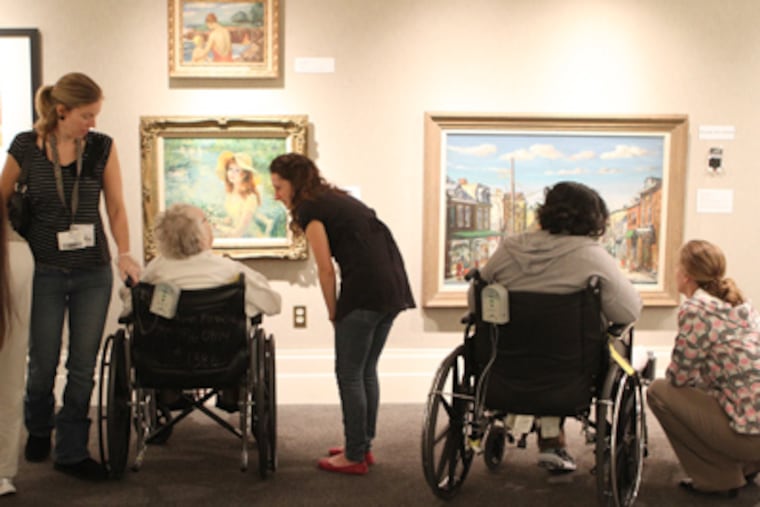Exhibit at Ursinus drew on views of those with dementia
The plastic glove dispenser inviting visitors to cover their hands is the first sign that an uncommon art exhibit is footsteps away.

The plastic glove dispenser inviting visitors to cover their hands is the first sign that an uncommon art exhibit is footsteps away.
Inside the second-floor gallery at Ursinus College's Berman Museum, an iPod offers a jazz soundtrack to a painting's abstract swish of colors. A sequined-and-studded Styrofoam bust mimics the contemporary art image that hangs above it.
"Please do touch," urges a nearby sign. The residents of Parkhouse, Montgomery County's long-term care and senior-living community in Royersford, do just that, and look around at the exhibit that they helped create.
The residents are visiting "Access-Ability: Deconstructing and Reconstructing Art for Access," an art show aimed at people with dementia and other cognitive disabilities.
The multisensory display is the Berman Museum's effort to provide a meaningful art experience to an underserved audience. To do that effectively, museum officials sought advice from the people they were attempting to reach.
"If we are going to target visitors with dementia, then we need to talk to people with dementia and have them say what they need," said Susan Shifrin, associate director for education at the Collegeville museum.
The exhibit, which runs through December, is part of a regional effort initiated by the Greater Philadelphia Women's Studies Consortium, which promotes college research on women, gender, and sexuality. Each year, the consortium encourages its 15 member schools to create programming associated with the consortium's scholar-in-residence.
This year's scholar, Rosemarie Garland-Thomson, a professor at Emory University, has done extensive research in disability studies.
Ursinus and Haverford College developed projects, both of which are on exhibit this fall.
Haverford's "What Can a Body Do?" is an artistic examination of the physical capabilities of a disabled body. The show runs through Dec. 16 at the school's Cantor Fitzgerald Gallery.
Nine artists showcase "the beauty inherent in disabled bodies" and tackle the "the big questions about how we respond to human variation," said Kristin Lindgren, director of the school's writing center and a visiting professor who helped organize the show.
In preparation for their exhibit, Ursinus staff members attended spring training workshops lead by Art Beyond Sight and ARTZ: Artists for Alzheimer's, two art accessibility advocacy groups. Ursinus has since joined ARTZ and is the first Pennsylvania museum to affiliate with the group.
At the training sessions, staffers learned strategies for selecting and displaying art, leading tours and creating the kind of multisensory experience that experts say enhance art appreciation for people with disabilities.
The Ursinus project, co-curated by students Emelie McFarland and Angier Cooper, included a focus group of Parkhouse residents who viewed and discussed slides from the Berman's permanent collection.
"It was about the pieces that generated lots of conversation," Shifrin said. If a piece met with silence, it was eliminated.
The result is an exhibit featuring mostly figurative and realistic depictions of people and places. They are the kinds of images that research has shown stimulate the functioning parts of the brain and evoke memories for people with cognitive disabilities.
In the Berman gallery, landscapes painted by Bucks County's Walter Emerson Baum hang near Norman Rockwell's wholesome depictions of family life. A few abstract pieces also made the cut, including a willowy steel sculpture by Harry Bertoia.
Baum's Adoration of the Maestro, a 1952 painting that depicts an art class and its nude model, was discussed by the Parkhouse residents when they visited the exhibit late last month.
"They look like they're learning how to paint," said Parkhouse resident Julia Atonuzzi, 78, as she gazed at the picture during a recent group visit to the exhibit.
"Well, [the model] looks like he's taking a whiz," said resident Gwen Scott, 49.
The group, most of whom observed the works from their wheelchairs, laughed loudly.
"Well, that gives us an interesting place to go," said Shifrin, who was conducting the tour. What followed was a discussion in which Shifrin used open-ended questions to encourage interpretation rather than right-or-wrong answers.
That's the strategy researchers suggest to avoid the frustration and agitation that visitors may display when they simply can't remember.
In this exhibit, "art isn't the be-all, end-all," Shifrin said. It's a vehicle that taps into the "vibrant parts of the person that are still there and allows them to come out."